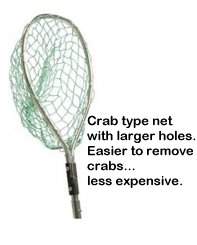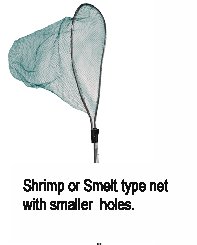 Crabs.........hmmmmmmmmmmmmmmm.
Crabs.........hmmmmmmmmmmmmmmm.
When you come to Ocean City,
Maryland with your children, especially if its for their first trip,
you just have to take them crabbing even if its just for a few
hours. Crabbing in Ocean City is very simple task, it doesn't take
any experience, and very little equipment.
Dining, Crabs, Restaurants
Equipment
for Crabbing: Net, String, and Bait.
The Net:
You can buy a very inexpensive net, at the Roses
Department Store in the 94th street mall. You could even rent one at
one of the local tackle shops. I've seen nets for sale at most of
the grocery stores in Ocean City like Foodlion and Superfresh. The
type of net you are looking for has a long pole 3 to 5 feet long and
a resembles a basketball hoop. The net is to swoop them out of the
water after you pull the crab in.
|
1a.) Net - The most extravagant
piece of |
2b.) The other type of net is called
a |
| Featured in Oprah Magazine We use only 100% hand-picked jumbo lump crab  |
The Bait for Crabs.
To catch crabs, one of the most
common methods is a simple piece of string and chicken necks or
chicken "backs", both very inexpensive, and sold obviously at
grocery stores, but sometimes you can even find them at 7-11 stores.
Often, some of the grocery stores will have nets and string, very
close to where they are selling the chicken parts you will use as
bait.
This next note is very important, especially on hot days at
the beach.
We STRONGLY recommend that you place the bait in a cooler
with ice. What we are trying to do is
keep the bait from spoiling, and just like any other food product,
it might spread disease and cause illness. So if you have children
with you we suggest that a parent handle the bait in the process of
crabbing. Remember you are handling a food product.
The crab usually smells the
bait in the water long before he sees it, and follows the scent
trail in the water to find the bait. If the bait becomes old, which
it does quickly, it won't give off a very good scent trail and the
crabs won't find it or know it is there. Changing the bait often
with fresh bait increases you chances... you'll figure this out as
you crab because you'll notice only catching crabs on the freshest
bait lines. Sometimes the bait will float because it has too much
fat on it... either pull or cut the fat off or get another piece of
bait. So you've got the bait, a net and string, and your keeping the
bait fresh... cut off lengths of the string 8 to 10 feet long, and
tie the string around the bait. That's about it except for tossing
the bait into the water, and then tying the other end to something,
or you can hold on to the string. Most people put more than one line
in the water to increase their chances. How will you know if you've
caught a crab.... sometime you won't know. Usually after you toss
the bait in the water there will be some slack in the string... the
crab will sneak up and start eating the bait, but usually the crab
likes to take the bait back to his/her hiding spot because they
don't like to share, or are afraid another bigger crab will come
along and steal it away. Sometimes you will even catch two crabs on
the same piece of bait, but usually those are only really small ones
that you shouldn't keep. There is a legal size of crabs that you can
keep, and they are measured "point to point", see below in the
pictures.
Catching the Crab.
Once you see the line moving
away or becoming taught because the crab has the bait, start pulling
the string in very slowly. Often there will not be any resistance to
pulling the line in, but there will be a crab on the bait. The crabs
don't really get caught on the bait, they just don't want to let go.
As the bait with the crab comes into your vision in the water very
carefully slip the net under the crab and swoop him/her up.
A very
good trick, and its good to have a helper for the net, is to put the
net in the water first and below where the line is coming in with
the crab, before you see the crab.. Using this technique the crab
won't become scared when he sees you put the net in the water
because it will already be there and he will think it is natural.
Usually the crab will jump off if he gets too close to the surface
of the water, so put the net as low as you can in the water, and
pull the string in from as low an angle as you can. Remember, pull
slowly on the string in a steady slow motion.
Where to crab.
Although often when swimming in the ocean the crabs will bite at
your toes, and thus you know there are crabs out there, but your
best bet will be on the bayside of Ocean City, known as Assawoman
Bay. There is also Sinepuxtent Bay, on the south end of Ocean City,
and Indian River Bay north of Ocean City in Delaware. Basically
anywhere on the bay. Your best locations for catching crabs will be
where the bottom comes up from a deep area quickly. This is opposed
to a long flat sloping area. Areas that tend to have a grassy
bottom, or mud type bottom are best as compared to an all sand
bottom. This is because the crab likes to hide either in the mud or
grassy areas from their enemies. Docks and piers are also good, and
along bulkheads (manmade wooden walls along the bay). You can pretty
much walk any where in Ocean City to the bayside and catch
crabs.
Crabbing
Locations:
126th
St. Northside Park 41st
Convention Center Chicago
Avenue Downtown
When to crab.
This is important. The best time to catch crabs is the incoming
tide, near and after the high tide. Go to our TIDE CHART and print
out a copy of the tides when you will be in Ocean City. But those
will be Ocean tides, and you will be on the bay. And thus you will
add an hour to the tide chart if you are in south OC, two to three
hours if you are near 65th Street, and four to six hours if you are
near the north end of OC 146th Street. You just don't want to crab
at low tide, high tide is the best. The crabs move in and out (up
and down the bay towards the ocean) with the tide. When the tide is
going low they are moving towards the ocean, high tide up the bay
away from the ocean. The higher the tide, the more of the land gets
submerged, and the more area and food for the crab to
feed.
Tide Chart for Ocean City
Maryland
Other techniques for crabbing.
Trot lines. This is basically one long line, with many shorter lines
attached with bait. Usually you need a boat for this method. Laying
the line out, and then going back and forth with the boat to check
the individual baits and pulling the crabs in. Traps. Traps are
good, but for the first time would probably be an added expense for
the beginner. There are many types of traps, large professional type
that you leave in the water for a day at time, and small collapsible
traps that when you pull them up they close and the crab can not
escape.
Crab Snares:
A new method and neat idea for catching crabs. You can use this crab
catching devise with your existing fishing pole or with string. For
more information about this neat idea click the link below.
http://crabsnares.com
Picking and Eating crabs.
CLiCK on over to
How to Pick
Crabs
Male Crabs and Female crabs.
The most definite distinction is the underside of the crab. Crabs
have a tab, or flap to their underside. The male crab's tab is long
and skinny, the female more rounded and wide. As in many species,
the female crab is less colorful.


Legal size of crabs.
Five inches "point to point".

Cooking crabs.
Please refer to your favorite cook book various gourmet cooking
methods. Basically steaming or boiling the crabs for 15 minutes to
20 minutes, the crab will turn bright red when done. If you find
that the crab meat, especially in the claws is very grainy and
sticks to the shells, your cooking time is too long. Try shortening
the cooking time on the next batch.
DO NOT EAT DEAD CRABS
Crab sizes point
to point legal to keep.
Delaware Peeler 3 inches Soft-shell 3 1/2 inches Hard-shell 5 inches
(except mature females) Crab pots may be used between March 1st
through November 30th. Limit of one bushel per crabber.
Maryland Peeler 3 inches Soft-shell 3 1/2 inches Hard-shell 5 inches
(except mature females)

Crab Snares:
A new method and neat idea for catching crabs. You can use this
crab catching devise with your existing fishing pole or with string.
For more information about this neat idea click the link below.
http://crabsnares.com


 With
a shrimping type net you will also be able to catch
minnows which is fun for the kids, but can also be used
for other types of fishing. Sometimes
crabs are a little harder to get out of a shrimping
type net with the finer mesh.
With
a shrimping type net you will also be able to catch
minnows which is fun for the kids, but can also be used
for other types of fishing. Sometimes
crabs are a little harder to get out of a shrimping
type net with the finer mesh.
